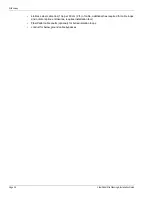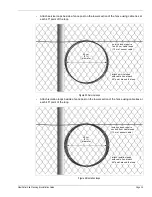
Page 36
FiberPatrol Site Planning & Installation Guide
Optical fiber safety
Fiber optic cable handling
FiberPatrol sensor cable performance specifications
The following manufacturer’s performance specifications apply to FiberPatrol sensor cable:
•
Fiber count (typical) 12, 24, 36, or 48 12/6 fibers/tube
•
Fiber type single-mode
•
Fiber wavelength 1550 nm
•
Manufacturer’s maximum cable attenuation 0.25 dB/km @ 1550 nm
•
Minimum allowable bend radius (dynamic) 220 mm (8.66 in.)
•
Minimum allowable bend radius (static) 110 cm (4.33 in.)
•
Minimum allowable bend radius (single fiber) 32 mm (1.25 in.)
•
Maximum allowable tensile rating during installation 2,700 N (600 lbf)
•
Crush resistance (short term) 220 N/cm (125 lbf)
•
Temperature ratings (storage) -40 to 75ºC (-40 to 167º F)
•
Temperature ratings (installation) -30 to 60ºC (-22 to 140º F)
•
Temperature ratings (operation) -40 to 70ºC (-40 to 158º F)
•
Typical outside diameter (may vary with cable type) 11.2 mm (0.44 in.)
•
Cable weight 93 kg/km (may vary with cable type) (62 lb/1,000 ft.)
•
Maximum available cable length 12 km (7.46 mi.)
Additional cable requirements
•
central strength member
•
water blocking tape
•
gel filled buffer tubes
•
rip cord
WARNING
Use care when working with exposed optical fibers. The bare fibers are
125 microns in diameter and can easily penetrate skin.
Always wear safety glasses when working with optical fibers.
Always dispose of bare fibers in a sealed and labeled container that is
specifically designed to contain fiber optic waste.
NEVER dispose of bare fibers in a standard waste receptacle.
Note
Standard FiberPatrol cable (p/n FPSP04XX - XX = number of fibers)
typically includes 12, 24, 36, or 48 optical fibers inside 1, 2, 3, or 4 gel
filled buffer tubes. The number of tubes and the number of fibers inside
each tube may vary, depending on the specific cable used at the site.
However, the basic cable construction and specifications are fixed
regardless of the number of tubes/fibers.






























